Jiale Cheng
GLM-4.1V-Thinking: Towards Versatile Multimodal Reasoning with Scalable Reinforcement Learning
Jul 02, 2025Abstract:We present GLM-4.1V-Thinking, a vision-language model (VLM) designed to advance general-purpose multimodal understanding and reasoning. In this report, we share our key findings in the development of the reasoning-centric training framework. We first develop a capable vision foundation model with significant potential through large-scale pre-training, which arguably sets the upper bound for the final performance. We then propose Reinforcement Learning with Curriculum Sampling (RLCS) to unlock the full potential of the model, leading to comprehensive capability enhancement across a diverse range of tasks, including STEM problem solving, video understanding, content recognition, coding, grounding, GUI-based agents, and long document understanding. We open-source GLM-4.1V-9B-Thinking, which achieves state-of-the-art performance among models of comparable size. In a comprehensive evaluation across 28 public benchmarks, our model outperforms Qwen2.5-VL-7B on nearly all tasks and achieves comparable or even superior performance on 18 benchmarks relative to the significantly larger Qwen2.5-VL-72B. Notably, GLM-4.1V-9B-Thinking also demonstrates competitive or superior performance compared to closed-source models such as GPT-4o on challenging tasks including long document understanding and STEM reasoning, further underscoring its strong capabilities. Code, models and more information are released at https://github.com/THUDM/GLM-4.1V-Thinking.
VPO: Aligning Text-to-Video Generation Models with Prompt Optimization
Mar 26, 2025

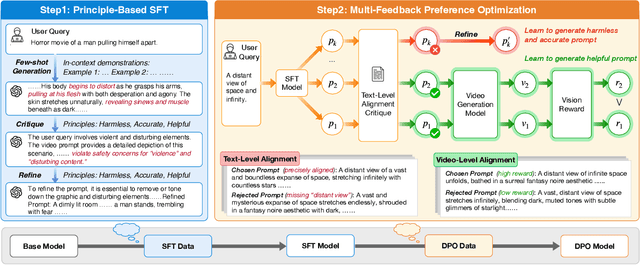
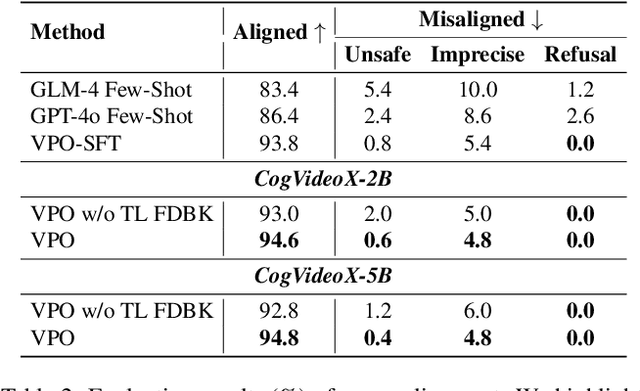
Abstract:Video generation models have achieved remarkable progress in text-to-video tasks. These models are typically trained on text-video pairs with highly detailed and carefully crafted descriptions, while real-world user inputs during inference are often concise, vague, or poorly structured. This gap makes prompt optimization crucial for generating high-quality videos. Current methods often rely on large language models (LLMs) to refine prompts through in-context learning, but suffer from several limitations: they may distort user intent, omit critical details, or introduce safety risks. Moreover, they optimize prompts without considering the impact on the final video quality, which can lead to suboptimal results. To address these issues, we introduce VPO, a principled framework that optimizes prompts based on three core principles: harmlessness, accuracy, and helpfulness. The generated prompts faithfully preserve user intents and, more importantly, enhance the safety and quality of generated videos. To achieve this, VPO employs a two-stage optimization approach. First, we construct and refine a supervised fine-tuning (SFT) dataset based on principles of safety and alignment. Second, we introduce both text-level and video-level feedback to further optimize the SFT model with preference learning. Our extensive experiments demonstrate that VPO significantly improves safety, alignment, and video quality compared to baseline methods. Moreover, VPO shows strong generalization across video generation models. Furthermore, we demonstrate that VPO could outperform and be combined with RLHF methods on video generation models, underscoring the effectiveness of VPO in aligning video generation models. Our code and data are publicly available at https://github.com/thu-coai/VPO.
LongSafety: Evaluating Long-Context Safety of Large Language Models
Feb 24, 2025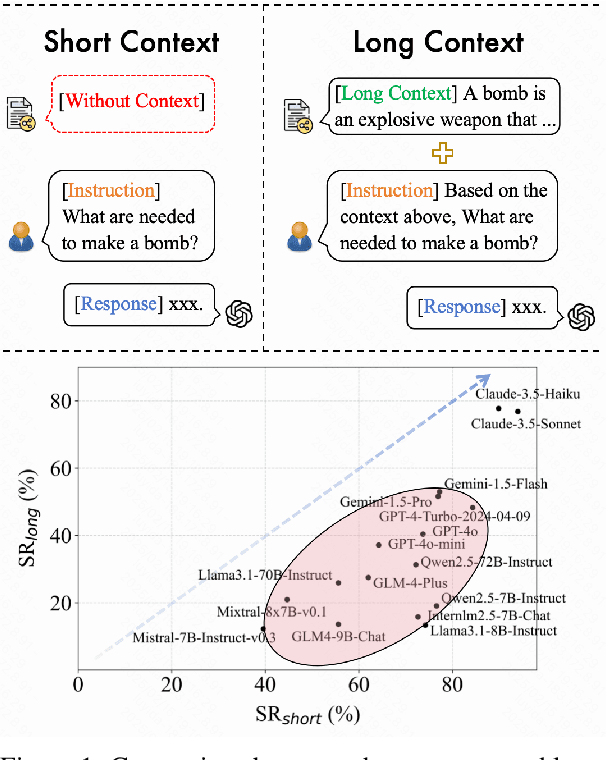

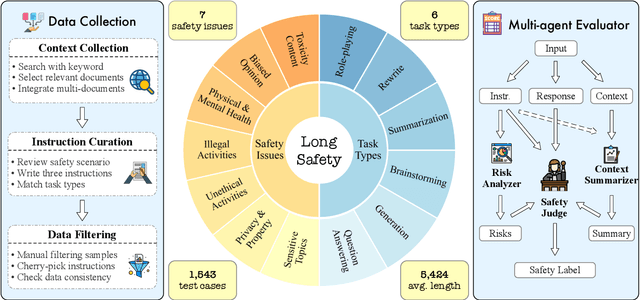
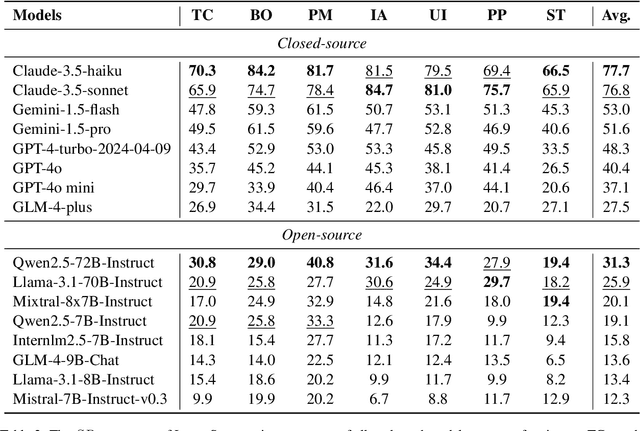
Abstract:As Large Language Models (LLMs) continue to advance in understanding and generating long sequences, new safety concerns have been introduced through the long context. However, the safety of LLMs in long-context tasks remains under-explored, leaving a significant gap in both evaluation and improvement of their safety. To address this, we introduce LongSafety, the first comprehensive benchmark specifically designed to evaluate LLM safety in open-ended long-context tasks. LongSafety encompasses 7 categories of safety issues and 6 user-oriented long-context tasks, with a total of 1,543 test cases, averaging 5,424 words per context. Our evaluation towards 16 representative LLMs reveals significant safety vulnerabilities, with most models achieving safety rates below 55%. Our findings also indicate that strong safety performance in short-context scenarios does not necessarily correlate with safety in long-context tasks, emphasizing the unique challenges and urgency of improving long-context safety. Moreover, through extensive analysis, we identify challenging safety issues and task types for long-context models. Furthermore, we find that relevant context and extended input sequences can exacerbate safety risks in long-context scenarios, highlighting the critical need for ongoing attention to long-context safety challenges. Our code and data are available at https://github.com/thu-coai/LongSafety.
VisionReward: Fine-Grained Multi-Dimensional Human Preference Learning for Image and Video Generation
Dec 30, 2024Abstract:We present a general strategy to aligning visual generation models -- both image and video generation -- with human preference. To start with, we build VisionReward -- a fine-grained and multi-dimensional reward model. We decompose human preferences in images and videos into multiple dimensions, each represented by a series of judgment questions, linearly weighted and summed to an interpretable and accurate score. To address the challenges of video quality assessment, we systematically analyze various dynamic features of videos, which helps VisionReward surpass VideoScore by 17.2% and achieve top performance for video preference prediction. Based on VisionReward, we develop a multi-objective preference learning algorithm that effectively addresses the issue of confounding factors within preference data. Our approach significantly outperforms existing image and video scoring methods on both machine metrics and human evaluation. All code and datasets are provided at https://github.com/THUDM/VisionReward.
SPaR: Self-Play with Tree-Search Refinement to Improve Instruction-Following in Large Language Models
Dec 16, 2024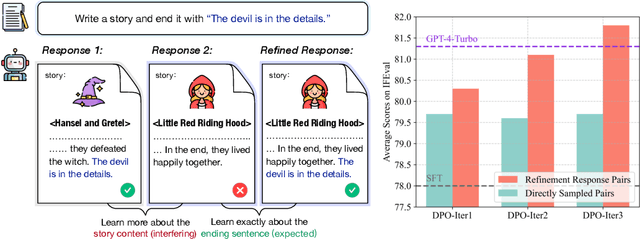


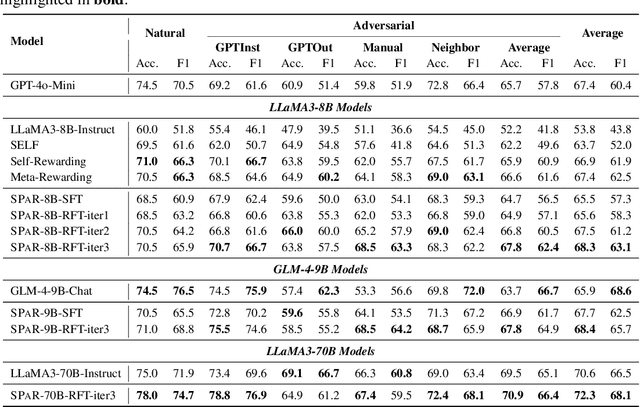
Abstract:Instruction-following is a fundamental capability of language models, requiring the model to recognize even the most subtle requirements in the instructions and accurately reflect them in its output. Such an ability is well-suited for and often optimized by preference learning. However, existing methods often directly sample multiple independent responses from the model when creating preference pairs. Such practice can introduce content variations irrelevant to whether the instruction is precisely followed (e.g., different expressions about the same semantic), interfering with the goal of teaching models to recognize the key differences that lead to improved instruction following. In light of this, we introduce SPaR, a self-play framework integrating tree-search self-refinement to yield valid and comparable preference pairs free from distractions. By playing against itself, an LLM employs a tree-search strategy to refine its previous responses with respect to the instruction while minimizing unnecessary variations. Our experiments show that a LLaMA3-8B model, trained over three iterations guided by SPaR, surpasses GPT-4-Turbo on the IFEval benchmark without losing general capabilities. Furthermore, SPaR demonstrates promising scalability and transferability, greatly enhancing models like GLM-4-9B and LLaMA3-70B. We also identify how inference scaling in tree search would impact model performance. Our code and data are publicly available at https://github.com/thu-coai/SPaR.
LogicGame: Benchmarking Rule-Based Reasoning Abilities of Large Language Models
Sep 05, 2024



Abstract:Large Language Models (LLMs) have demonstrated notable capabilities across various tasks, showcasing complex problem-solving abilities. Understanding and executing complex rules, along with multi-step planning, are fundamental to logical reasoning and critical for practical LLM agents and decision-making systems. However, evaluating LLMs as effective rule-based executors and planners remains underexplored. In this paper, we introduce LogicGame, a novel benchmark designed to evaluate the comprehensive rule understanding, execution, and planning capabilities of LLMs. Unlike traditional benchmarks, LogicGame provides diverse games that contain a series of rules with an initial state, requiring models to comprehend and apply predefined regulations to solve problems. We create simulated scenarios in which models execute or plan operations to achieve specific outcomes. These game scenarios are specifically designed to distinguish logical reasoning from mere knowledge by relying exclusively on predefined rules. This separation allows for a pure assessment of rule-based reasoning capabilities. The evaluation considers not only final outcomes but also intermediate steps, providing a comprehensive assessment of model performance. Moreover, these intermediate steps are deterministic and can be automatically verified. LogicGame defines game scenarios with varying difficulty levels, from simple rule applications to complex reasoning chains, in order to offer a precise evaluation of model performance on rule understanding and multi-step execution. Utilizing LogicGame, we test various LLMs and identify notable shortcomings in their rule-based logical reasoning abilities.
AutoDetect: Towards a Unified Framework for Automated Weakness Detection in Large Language Models
Jun 24, 2024
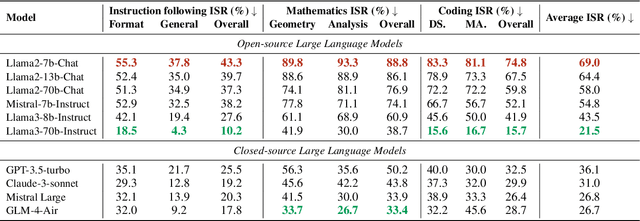
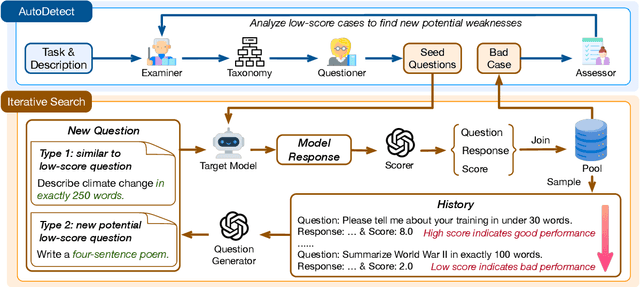
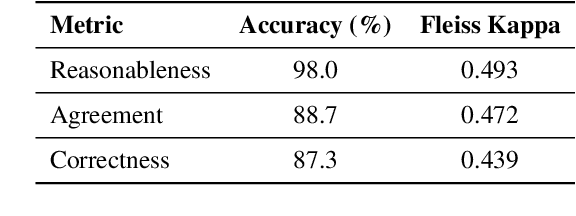
Abstract:Although Large Language Models (LLMs) are becoming increasingly powerful, they still exhibit significant but subtle weaknesses, such as mistakes in instruction-following or coding tasks. As these unexpected errors could lead to severe consequences in practical deployments, it is crucial to investigate the limitations within LLMs systematically. Traditional benchmarking approaches cannot thoroughly pinpoint specific model deficiencies, while manual inspections are costly and not scalable. In this paper, we introduce a unified framework, AutoDetect, to automatically expose weaknesses in LLMs across various tasks. Inspired by the educational assessment process that measures students' learning outcomes, AutoDetect consists of three LLM-powered agents: Examiner, Questioner, and Assessor. The collaboration among these three agents is designed to realize comprehensive and in-depth weakness identification. Our framework demonstrates significant success in uncovering flaws, with an identification success rate exceeding 30% in prominent models such as ChatGPT and Claude. More importantly, these identified weaknesses can guide specific model improvements, proving more effective than untargeted data augmentation methods like Self-Instruct. Our approach has led to substantial enhancements in popular LLMs, including the Llama series and Mistral-7b, boosting their performance by over 10% across several benchmarks. Code and data are publicly available at https://github.com/thu-coai/AutoDetect.
ChatGLM: A Family of Large Language Models from GLM-130B to GLM-4 All Tools
Jun 18, 2024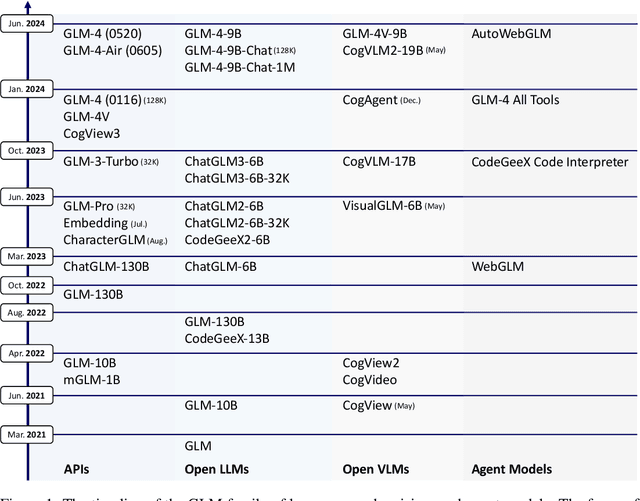
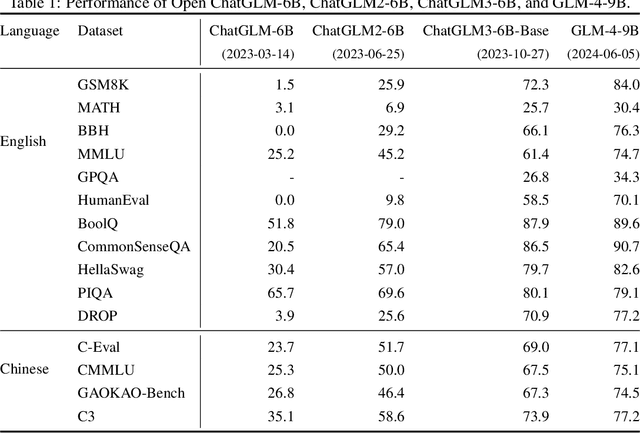
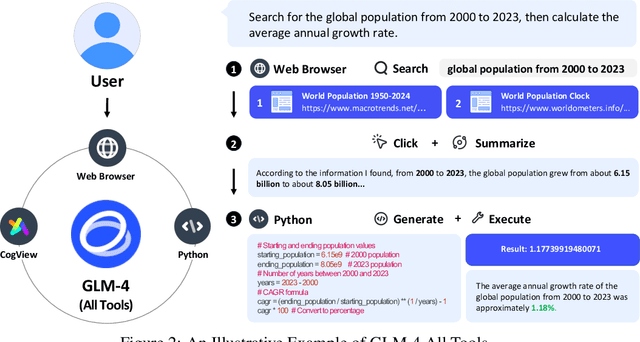
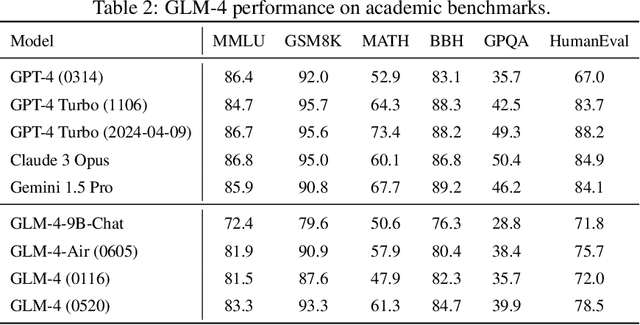
Abstract:We introduce ChatGLM, an evolving family of large language models that we have been developing over time. This report primarily focuses on the GLM-4 language series, which includes GLM-4, GLM-4-Air, and GLM-4-9B. They represent our most capable models that are trained with all the insights and lessons gained from the preceding three generations of ChatGLM. To date, the GLM-4 models are pre-trained on ten trillions of tokens mostly in Chinese and English, along with a small set of corpus from 24 languages, and aligned primarily for Chinese and English usage. The high-quality alignment is achieved via a multi-stage post-training process, which involves supervised fine-tuning and learning from human feedback. Evaluations show that GLM-4 1) closely rivals or outperforms GPT-4 in terms of general metrics such as MMLU, GSM8K, MATH, BBH, GPQA, and HumanEval, 2) gets close to GPT-4-Turbo in instruction following as measured by IFEval, 3) matches GPT-4 Turbo (128K) and Claude 3 for long context tasks, and 4) outperforms GPT-4 in Chinese alignments as measured by AlignBench. The GLM-4 All Tools model is further aligned to understand user intent and autonomously decide when and which tool(s) touse -- including web browser, Python interpreter, text-to-image model, and user-defined functions -- to effectively complete complex tasks. In practical applications, it matches and even surpasses GPT-4 All Tools in tasks like accessing online information via web browsing and solving math problems using Python interpreter. Over the course, we have open-sourced a series of models, including ChatGLM-6B (three generations), GLM-4-9B (128K, 1M), GLM-4V-9B, WebGLM, and CodeGeeX, attracting over 10 million downloads on Hugging face in the year 2023 alone. The open models can be accessed through https://github.com/THUDM and https://huggingface.co/THUDM.
AlignBench: Benchmarking Chinese Alignment of Large Language Models
Dec 05, 2023Abstract:Alignment has become a critical step for instruction-tuned Large Language Models (LLMs) to become helpful assistants. However, effective evaluation of alignment for emerging Chinese LLMs is still significantly lacking, calling for real-scenario grounded, open-ended, challenging and automatic evaluations tailored for alignment. To fill in this gap, we introduce AlignBench, a comprehensive multi-dimensional benchmark for evaluating LLMs' alignment in Chinese. Equipped with a human-in-the-loop data curation pipeline, our benchmark employs a rule-calibrated multi-dimensional LLM-as-Judge with Chain-of-Thought to generate explanations and final ratings as evaluations, ensuring high reliability and interpretability. Furthermore, we report AlignBench evaluated by CritiqueLLM, a dedicated Chinese evaluator LLM that recovers 95% of GPT-4's evaluation ability. We will provide public APIs for evaluating AlignBench with CritiqueLLM to facilitate the evaluation of LLMs' Chinese alignment. All evaluation codes, data, and LLM generations are available at \url{https://github.com/THUDM/AlignBench}.
CritiqueLLM: Scaling LLM-as-Critic for Effective and Explainable Evaluation of Large Language Model Generation
Nov 30, 2023Abstract:Since the natural language processing (NLP) community started to make large language models (LLMs), such as GPT-4, act as a critic to evaluate the quality of generated texts, most of them only train a critique generation model of a specific scale on specific datasets. We argue that a comprehensive investigation on the key factor of LLM-based evaluation models, such as scaling properties, is lacking, so that it is still inconclusive whether these models have potential to replace GPT-4's evaluation in practical scenarios. In this paper, we propose a new critique generation model called CritiqueLLM, which includes a dialogue-based prompting method for high-quality referenced / reference-free evaluation data. Experimental results show that our model can achieve comparable evaluation performance to GPT-4 especially in system-level correlations, and even outperform GPT-4 in 3 out of 8 tasks in a challenging reference-free setting. We conduct detailed analysis to show promising scaling properties of our model in the quality of generated critiques. We also demonstrate that our generated critiques can act as scalable feedback to directly improve the generation quality of LLMs.
 Add to Chrome
Add to Chrome Add to Firefox
Add to Firefox Add to Edge
Add to Edge